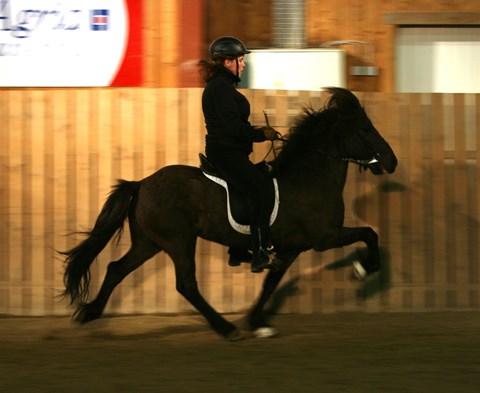
Half halt
November 18, 2008
"Mr. Larusson, when you come around to the next corner I want you to give half halt to the horse and continue to do so every step while you are riding the corner," echoed a voice throughout the riding arena at Oregon State University a bit more than one decade ago. When I had passed the corner, the voice said again, this time enunciating each word so not to be mistaken, "Mr. Larusson, I saw that you did not give a single half halt. Why not?"
" I do not know what half halt is" I replied in broken English embarrassed for not knowing.
"What!? You don't know what half halt is, and you are a riding instructor in Iceland?" said the voice a bit surprised, where its owner, a grand prix riding instructor and competitor, stood in front of me.
"While riding a horse, you follow the horse's movement of it's gait and when you perform half half, you stop moving with the gait by stiffening your entire body for an instant" he explained. "Try it now in walk and I will tell you when the horse responds in the correct manner." After a few tries the half halt began to work. "Notice the reaction of the horse when you give a half halt that works" he instructed. Then, a few moments later, he asked, "Now, what reaction do you get from the horse with a half halt?"
"It seems that the horse's ears turn backwards each time I give him half halt," I said timidly. "And what else?" he asked after a short silence. "It seems the horse slows down and I feel his back lifting." I answered.
"You are discovering the influence of the half halt," said the instructor. "Two things occur when you use half halt. On the one hand you get the horse's attention which you can see when the horse tilts his ears back. It is important to understand that the horse is more likely to do as he is asked when his attention is to the rider. On the other hand, the horse engages the hindquarters which feels to the rider as if the back is being lifted. When the horse engages the hindquarters then the horse goes off the forehand and the horse's balance increases. And there you have it," my instructor said as he concluded his monologue.
"And when do you use half half," I asked, just so I could be certain about the technique. "Well. I think I have instructed you correctly Mr. Larusson. You only use the half halt when you need to get the horses attention before you are going to ask him to change something like the speed, gait or direction of the horse. You can also use half halt to increase the horses balance when you think he is going to go on the forehand, is in a turn, or you are preparing collection or maintain collection.”
"So, what you are telling me is that I will need to use half halt constantly when I am riding a horse," I said with a hint of disbelief in my voice. "Yes, if you are going to effectively ride the horse and have him listen to you," my instructor replied as he finished the riding lesson.
Do you use half halt when you are on horseback?
Magnús Lárusson
Picture shows Svanhildur and Kráka at a breeding show. Both have learned to understand half halt!
